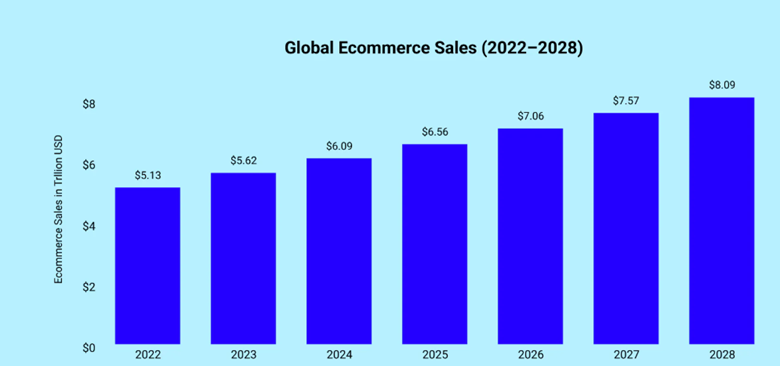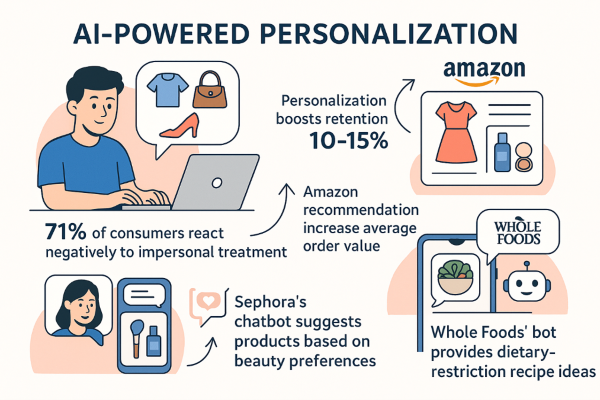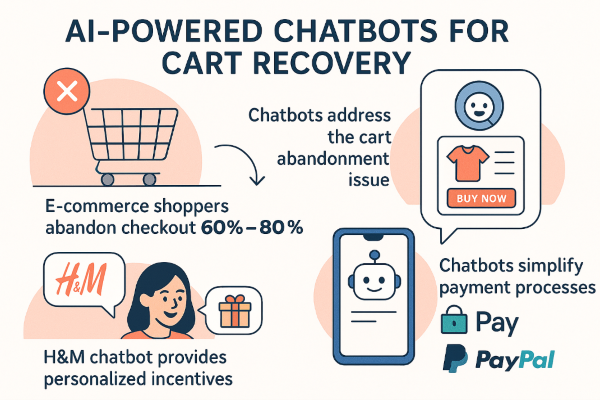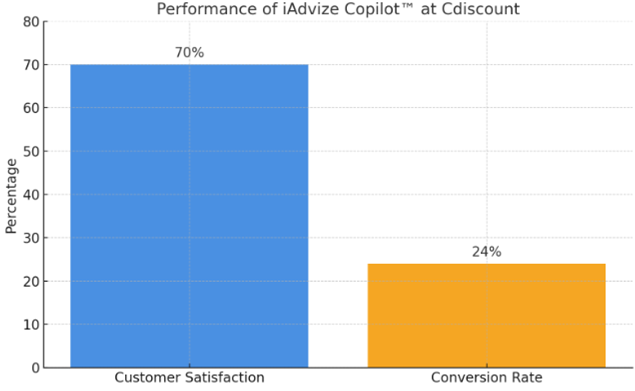
Artificial Intelligence (AI) has transformed the e-commerce sector through substantial shifts observed throughout recent years. Shopping chatbots powered by AI represent transformative innovations because they have fundamentally changed business-customer interactions. These digital helpers now surpass automated responses to provide intelligent solutions that enhance customer engagement, business success, and operational efficiency. Chatbots stand as a leading innovation in the digital revolution of e-commerce. Thus, transforming online shopping into a personalized, efficient, and accessible experience. The global e-commerce market is projected to expand from $6.56 trillion in 2025 to $8.1 trillion by 2028.

Global E-commerce scale (2022-2028)
The article describes how and why AI chatbots are transforming the e-commerce industry. Furthermore, it also discusses their advantages and drawbacks alongside supporting data from case studies and figures.
The Rise of AI Shopping Chatbots in E-commerce
By utilizing natural language processing, learning, and generative AI, chatbots are intelligent agents that operate within the framework of natural language processing (NLP). Modern chatbots demonstrate the ability to interpret contextual meaning and emotional states, as well as the capability to engage in human-like dialogues. Statista reveals that 24% of U.S. shoppers use chatbots for their shopping needs, while 61% appreciate their round-the-clock service and 45% value instant responses.
E-commerce chatbots are used by 1.4 billion consumers globally, and the trend toward using such communication methods has increased the rate by 92% over the last few years. It is deployed on multiple platforms, including websites, applications, and social media platforms such as Instagram, WhatsApp, and Facebook Messenger. These company representatives handle various tasks, including product recommendations, order tracking, payment support, and customer service activities, to deliver essential support that meets modern customer expectations.
How Chatbots Enhance the Shopping Experience
The following are some key points where chatbots play their role in enhancing the shopping experience.
1. Personalized Product Recommendations
E-commerce operates through personalized approaches because 71% of consumers respond negatively to generic treatment. AI chatbots use data about user browsing activities and purchase behavior alongside personal preferences for making customized product recommendations.
The recommendation system of Amazon relies on limited memory AI to evaluate previous interactions and drive up average order values by 50% through its product recommendations. Customer retention increases by 10-15% through AI-based personalization strategies, while the system facilitates revenue growth by presenting suitable products and related offers tailored to each customer.
Facebook Messenger users find examples of this capability through Sephora’s chatbot interface. The system collects information about users’ beauty preferences and then utilizes this data to recommend products, resulting in enhanced user engagement and improved purchase outcomes. Through its bot, Whole Foods offers recipe options tailored to dietary restrictions, aiding health-driven shoppers throughout their shopping process.

2. 24/7 Customer Support
Chatbots offer continuous customer support as a major advantage due to their automated availability, regardless of the time or day. The constant availability of chatbots surpasses that of human operators by eliminating waiting periods and creating a more seamless customer experience.
Gartner anticipates that chatbots will become the primary customer service channel by 2027, driven by their financial advantages and the ability to create positive emotional customer interactions. The automation of support inquiries that occur frequently reaches up to 95%, allowing human agents to focus on handling more complex interactions.
3. Streamlined Checkout and Reduced Cart Abandonment
E-commerce stores face a persistent cart abandonment problem, as their typical shoppers bounce from checkout between 60% and 80% of the time. A vast number of customers who create shopping carts ultimately fail to finalize transactions, resulting in a high abandonment rate. AI-powered chatbots solve the cart abandonment problem through their capability to send prompt alerts about abandoned carts while assisting users in finishing purchases.
The H&M chatbot encourages customers to finalize their orders by offering customized rewards, which helps recover revenue. Chatbots simplify payment processes by connecting with various payment gateways, allowing users to complete transactions directly within the chat platform.

4. Omnichannel Engagement
Today, consumers engage with brands in various ways – socially through social media, visiting websites, and using mobile applications. Chatbots also present a single system of information by integrating it across channels. For instance, a client who enquires about a particular product through a brand’s Instagram page can be further followed up via email or through WhatsApp. Zalando’s chatbot is designed to suggest outfits for customers, operating across various channels and contributing to the company’s revenue growth.
5. Conversational Commerce and Data Insights
Conversational commerce integrated into a chatbot means that with the help of generative AI, a chatbot can complete a transaction through a natural language conversation. Studies have found that companies using artificial intelligence operate more efficiently. Cdiscount, a major French e-commerce company, has adopted the iAdvize Copilot for Shoppers, which has achieved 70% customer satisfaction and a 24% conversion rate following discussions with the company’s counterparts and human advisors.
It is also important to note that chatbots gather information that can help in understanding customers and their behavioral patterns, which assists in modifying existing approaches, among others, in the business domain. It explains that through the analysis of the flow of interactions with the targeted chatbots, it becomes easier to segment clients based on their propensity to purchase specific products, optimize recommendations for particular products, and minimize bounce rates by providing more relevant results in search results.

Challenges and Limitations of Shopping Chatbots
It is, however, understood that AI chatbots encounter some challenges. The major drawback of such responses is that they occasionally do not understand the context of the request and respond illogically. Research shows that 95% of customers rely on human support to complete online purchases, as chatbots often fail to answer pre-purchase questions.
Data privacy is another concern. Data privacy and security risks were registered as risks associated with AI by 56% of the surveyed Fortune 500 companies. It is noted in their annual reports to the market, as per Arize AI.
The effective implementation of a policy of transparency is considered a key prerequisite for building customer trust and ensuring compliance with regulations. However, anthropomorphic chatbots increase credibility as long as they are perceived as non-artificial, since consumers with situational loneliness may not trust an anthropomorphic chatbot.
Teams must closely monitor all these factors and conduct regular training to overcome the challenges. Businesses can use advanced analytics to measure sentiment analysis, escalating rates in communication, and the overall effectiveness of the chatbot in interaction.
Real-World Success Stories
- Cdiscount: Cdiscount utilized iAdvize’s solutions to implement a generative AI chatbot, which accounted for 40% of customer discussions. This approach met or exceeded the conversion rate of human agents. Moreover, it even surpassed the traditional chatbots’ index of customer satisfaction.
- Vanden Borre: This Belgian retailer achieved an 80% customer satisfaction score by utilizing iAdvize’s Copilot™ in pre-sales support and guidance. Hence, resulting in a significant reduction in the human resources required.
- Whole Foods: Another key aspect of the business’s excellence is the service that utilizes a Facebook Messenger bot. It provides nutritional information and recipes tailored to targeted customers, thereby fostering loyalty among health-conscious consumers.
The Future of AI Shopping Chatbots in E-commerce
The obvious areas for improvement within the chatbot are the utilization of features such as emotional intelligence and voice recognition. Sentiment analysis itself enables chatbots to identify customers’ emotions, thus transferring infamous users to agents. The use of NLP in voice-based chatbots is gaining popularity. It makes communication more convenient and personal for users.
Generative AI will enhance the capabilities of chatbot queries. It will also enable the generation of content such as product descriptions and advertisements. With the advancement of AI, chatbots will coordinate with AR. This will help create virtual stores where consumers can try out products virtually.
Conclusion
Shopping chatbots are transforming e-commerce by automating the entire shopping process. From availability around the clock to site customization and one-click purchasing, they meet the expectations of today’s customers. They also enhance sales. These are some of the ways AI is overcoming gaps despite current limitations and hurdles. For instance, it includes privacy issues and contextual constraints.
Thus, decomposition is spreading to products, experiments, and brands such as Cdiscount, Sephora, and Whole Foods. Brands have been using chatbots not only as smart tools but as active assets. However, they do this in the pursuit of higher customer satisfaction and conversion rates.
Due to the constant growth of the e-commerce market, those who adopt AI chatbots will stay ahead of competitors. They will also offer the best shopping experience customers have come to expect in the digital space.
Pingback: AI Shopping Cart Revolution: Personalized Online Shopping